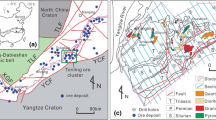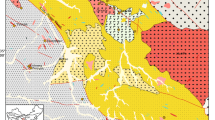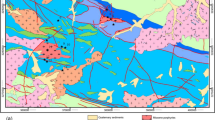Highlights
-
Actual geological data, accurate models and precise samples are critical for ore targeting.
-
The RF-based prediction model is more applicable for mapping mineral prospectivity than other algorithms in this study.
-
The determination of sample set is more important than algorithm if there is not enough field data.
Abstract
Successful delineation of high potential targets for exploration in maturely-explored orefields is still a tough challenge. A reliable prediction model achieved by integration of various ore-related geological factors and exploration information in the 3D space is an effective approach to deal with this challenge. The Anqing orefield has been intensively exploited for decades, and thereby the possible potential left must be at depth. The accumulated abundant data of exploration and research provide us a possibility for carrying out machine learning-based 3D modeling. The 3D block models of the main geological bodies, resistivity and volumetric strain field in this orefield were used as multi-resource geological data to construct prediction models by using weight-of-evidence and machine learning methods. Through performance evaluation and comparison, the following conclusions were obtained: (1) it is more scientific and reasonable to use all the geological prospecting factors concurrently for mineral prospectivity mapping (MPM) rather than use one or a part of them; (2) random forest (RF) algorithm seems capable of MPM because of its high accuracy and reliability in prediction; and (3) rational selection of training and learning samples, especially, those from actual geological objects and exploration engineering, plays a more critical role in MPM than algorithm and methods themselves. Two different RF prediction models were obtained for MPM in the east and the surrounding part of this orefield based on the outcome of geophysical prospecting. The spaces with prediction probabilities higher than 0.508 in the east part and 0.501 in the surroundings take up only 3.71% volume of the whole orefield, but contain 95.92% of the mineralized blocks. The high potential targets are most likely parts of the above spaces with high prediction probabilities that have not been drilled yet up to now.














Similar content being viewed by others
References
Abedi, M., Noruzi, G. H., & Bahroudi, A. (2012). Support vector machine for multi-classification of mineral prospectivity areas. Computers & Geosciences, 46(3), 272–283.
Agterberg, F. P., Bonham-Carter, G. F., & Wright, D. F. (1990). Statistical pattern integration for mineral exploration. Computer Applications in Resource Estimation, 1–21.
Agterberg, F. P., & Cheng, Q. (2002). Conditional independence test for weights-of-evidence modeling. Natural Resources Research, 11(4), 249–255.
Bonham-Carter, G. F. (1994). Geographic information systems for geoscientists: Modelling with GIS (p. 398). Pergamon.
Bonham-Carter, G. F., Agterberg, F. P., & Wright, D. F. (1989). Weights of evidence modeling: A new approach to mapping mineral potential. Geological Survey of Canada, 89(9), 171–183.
Boser, B.E., Guyon, I.M., & Vapnik, V.N. (1992). A training algorithm for optimal margin classifiers. In Proceedings of the fifth annual workshop on Computational learning theory, ACM, pp. 144–152.
Breiman, L. (1996). Bagging predictors. Machine Learning, 24(2), 123–140.
Breiman, L. (2001). Random forests. Machine Learning, 45, 5–32.
Brown, W. M., Gedeon, T. D., Groves, D. I., & Barnes, R. G. (2000). Artificial neural networks: A new method for mineral prospectivity mapping. Journal of the Geological Society of Australia, 47(4), 757–770.
Carranza, E. J. M. (2004). Weights of evidence modeling of mineral potential: A Case Study Using Small Number of Prospects, Abra. Philippines. Natural Resources Research, 13(3), 173–187.
Carranza, E. J. M. (2008). Geochemical anomaly and mineral prospectivity mapping in GIS. In Handbook of exploration and environmental geochemistry (Vol. 11, p. 351). Amsterdam: Elsevier.
Carranza, E. J. M. (2015). Data-Driven Evidential Belief Modeling of Mineral Potential Using Few Prospects and Evidence with Missing Values. Natural Resources Research, 24(3), 291–304.
Carranza, E. J. M., & Laborte, A. G. (2015). Random forest predictive modeling of mineral prospectivity with small number of prospects and data with missing values in Abra (Philippines). Computers & Geosciences, 74(2015), 60–70.
Carranza, E. J. M., & Laborte, A. G. (2016). Data-driven predictive modeling of mineral prospectivity using random forests: A case study in catanduanes island (Philippines). Natural Resources Research, 25(1), 1–16.
Carranza, E. J. M., Ruitenbeek, F. J. A. V., Hecker, C., Meijde, M. V. D., & Meer, F. D. V. D. (2008). Knowledge-guided data-driven evidential belief modeling of mineral prospectivity in Cabo de Gata, SE Spain. International Journal of Applied Earth Observation & Geoinformation, 10(3), 387.
Caté, A., Schetselaar, E., Mercier-Langevin, P., & Ross, P. S. (2018). Classification of lithostratigraphic and alteration units from drillhole lithogeochemical data using machine learning: A case study from the Lalor volcanogenic massive sulphide deposit, Snow Lake, Manitoba, Canada. Journal of Geochemical Exploration, 216–228.
Chang, Y. F., Liu, X. P., & Wu, Y. C. (1991). The Copper–Iron Belt of the Low and Middle Reaches of the Yangtze River. Geological Publish House: Beijing, China, pp. 359. (In Chinese)
Chen, G. D. (1982). Polygenetic compound ore deposits and their origin in the context of regularities in crustal evolution. Geotectonica Et Metallogenia, 1, 1–27. (In Chinese).
Chen, J. P., Peng, L., Wen, W., Zhao, J., & Qing, H. (2007). A 3-d prediction method for blind orebody based on 3-d visualization model and its application. Earth Science Frontiers, 14(5), 54–61.
Chen, Y. L. (2015). Mineral potential mapping with a restricted Boltzmann machine. Ore Geology Reviews, 71, 749–760.
Chung, C. F., & Agterberg, F. P. (1980). Regression models for estimating mineral resources from geological map data. Journal of the International Association for Mathematical Geology’s, 12(5), 473–488.
Cracknell, M. J., & Reading, A. M. (2014). Geological mapping using remote sensing data: A comparison of five machine learning algorithms, their response to variations in the spatial distribution of training data and the use of explicit spatial information. Computers & Geosciences, 63, 22–33.
Cristianini, N., & Shawe-Taylor, J. (2000). An Introduction to Support Vector Machines and Other Kernel-Based Learning Methods. https://doi.org/10.1017/CBO9780511801389:173-186.
Cutler, A., Cutler, D. R., & Stevens, J. R. (2012). Random forests. Ensemble machine learning (pp. 157–175). Springer.
Delong, E. R., Delong, D. M., & Clarke-Pearson, D. L. (1988). Comparing the areas under two or more correlated receiver operating characteristic curves: A nonparametric approach. Biometrics, 44(3), 837–845.
Dong, S. W., & Qiu, R. L. (1993). Tectonism and magmatism in the anqing-Yueshan Area. Geological Publishing House: Beijing, China, pp. 154. (In Chinese)
Eugenio, B. D., & Glass, M. (2004). The kappa statistic: A second look. Computational Linguistics, 30(1), 95–101.
Fabbri, A. G., & Chang-Jo, C. (2008). On blind tests and spatial prediction models. Natural Resources Research, 17, 107–118.
Fayyad, U. M., & Irani, K. B. (1992). The attribute selection problem in decision tree generation. National Conference on Artificial Intelligence, 104–110.
Harris, D. V., & Pan, G. (1999). Mineral favorability mapping: a comparison of artificial neural networks, logistic regression, and discriminant analysis. Natural Resources Research, 8(2), 93–109.
Haykin, S. (1994). Neural Networks: A Comprehensive Foundation. Neural Networks A Comprehensive Foundation, 71–80.
Ho, T. K. (1998). The random subspace method for constructing decision forests. IEEE Transactions on Pattern Analysis and Machine Intelligence, 20(8), 832–844.
Hood, S., Cracknell, M., & Gazley, M. (2018). Linking protolith rocks to altered equivalents by combining unsupervised and supervised machine learning. Journal of Geochemical Exploration, 186, 270–280.
Hopfield, J. J. (1988). Artificial neural networks. IEEE Circuits & Devices Magazine, 4(5), 3–10.
Keller, J. M., Gray, M. R., & Givens, J. A. (1985). A fuzzy k-nearest neighbor algorithm. IEEE Transactions on Systems, Man, and Cybernetics, 4, 580–585.
Lesmeister, C. (2017). Mastering machine learning with R: Advanced prediction, algorithms, and learning methods with R 3.x. Birmingham: Packt Publishing.
Li, F. Y., Pan, M., & Zhu, L. (2005). Research on the Algorithm for 3D Raster Buffer-Generation. Journal of Computer-Aided Design & Computer Graphics, 17(9), 1928–1932. (In Chinese with English Abstract).
Li, X. H. (2016). Using “random forest” for classification and regression. Chinese Journal of Applied Entomology, 50(04), 1190–1197. (In Chinese with English Abstract).
Li, X. H., Yuan, F., Zhang, M. M., Jowitt, S. M., Ord, A., Zhou, T. F., & Dai, W. Q. (2019). 3D computational simulation-based mineral prospectivity modeling for exploration for concealed Fe–Cu skarn-type mineralization within the Yueshan orefield, Anqing district, Anhui Province, China. Ore Geology Reviews, 105, 1–17.
Liu, L. M., Shu, Z. M., Zhao, C. B., Wan, C. L., Cai, A. L., & Zhao, Y. L. (2008). The controlling mechanism of ore formation due to flow-focusing dilation spaces in skarn ore deposits and its significances for deep-ore exploration: Examples from the Tongling-Anqing district. Acta Petrologica Sinica, 24, 1848–1856. (In Chinese with English Abstract).
Liu, L. M., Wan, C. L., Zhao, C. B., & Zhao, Y. L. (2011). Geodynamic constraints on orebody localization in the Anqing orefield, China: Computational modeling and facilitating predictive exploration of deep deposits. Ore Geology Reviews, 43, 249–263.
Liu, L. M., Zhao, Y. L., & Sun, T. (2012). 3D computational shape- and cooling process-modeling of magmatic intrusion and its implication for genesis and exploration of intrusion-related ore deposits: An example from the Yueshan intrusion in Anqing, China. Tectonophysics, 526, 110–123.
Loomis, J. M. (1982). Analysis of tactile and visual confusion matrices. Perception and Psychophysics, 31(1), 41–52.
Lowd, D., & Domingos, P. (2005). Naive Bayes models for probability estimation. In Proceedings of the 22nd international conference on Machine learning, ACM, pp. 529–536
Mao, J. W., Xie, G. Q., Duan, C., Pirajno, F., Ishiyama, D., & Chen, Y. C. (2011). A tectono-genetic model For Porphyry–Skarn–Stratabound Cu–Au–Mo–Fe and magnetite-apatite deposits along the middle-lower Yangtze River Valley, Eastern China. Ore Geology Reviews, 43, 294–314.
Mckay, G., & Harris, J. R. (2016). Comparison of the data-driven random forests model and a knowledge-driven method for mineral prospectivity mapping: A case study for gold deposits around the huritz group and nueltin suite, nunavut, canada. Natural Resources Research, 25(2), 125–143.
Miesch, A. T. (1980). Scaling variables and interpretation of eigenvalues in principal component analysis of geologic data. Journal of the International Association for Mathematical Geology, 12(6), 523–538.
Nielsen, S.H.H., Cunningham, F., Hay, R., Partington, G., & Stokes, M. (2015). 3D prospectivity modelling of orogenic gold in the Marymia Inlier, Western Australia. Ore Geology Reviews, 578–591.
Othman, A. A., & Gloaguen, R. (2017). Integration of spectral, spatial and morphometric data into lithological mapping: A comparison of different Machine Learning Algorithms in the Kurdistan Region, NE Iraq. Journal of Asian Earth Sciences, 90–102.
Pan, Y., & Dong, P. (1999). The lower chanjiang (yangzi/yangzte river) metallogenic belt, east china: Intrusion- and wall rock-hosted cu-fe-au, mo, zn, pb and ag deposits. Ore Geology Reviews, 15, 177–242.
Payne, C. E., Cunningham, F., Peters, K. J., Nielsen, S. H., Puccioni, E., Wildman, C., & Partington, G. (2015). From 2D to 3D: Prospectivity modelling in the Taupo Volcanic Zone, New Zealand. Ore Geology Reviews, 558–577.
Porwal, A. (2003). Knowledge-driven and data-driven fuzzy models for predictive mineral potential mapping. Natural Resources Research, 12(1), 1–25.
Porwal, A., & Carranza, E. J. M. (2015). Introduction to the Special Issue: GIS-based mineral potential modelling and geological data analyses for mineral exploration. Ore Geology Reviews, 477–483.
Porwal, A., González-álvarez, I., Markwitz, V., Mccuaig, T. C., & Mamuse, A. (2010). Weights-of-evidence and logistic regression modeling of magmatic nickel sulfide prospectivity in the yilgarn craton, western australia. Ore Geology Reviews, 38(3), 184–196.
Qin, Y. Z., & Liu, L. M. (2018). Quantitative 3D association of geological factors and geophysical fields with mineralization and its significance for ore prediction: An example from anqing Orefield, China. Minerals, 8(7), 300.
Qin, Y. Z., Wu, W. C., Xie, L. F., Ou, P. H., & Huang, X. L. (2021). Application of machine learning based mineral prospectivity mapping in the Yuexi Antimony Orefield, Hunan province. Journal of East China University of Technology (natural Science), 01(004), 28–40. (In Chinese with English Abstract).
Quinlan, J. R. (1986). Induction of decision trees. Machine Learning, 1(1), 81–106.
Rodriguez-Galiano, V., Sanchez-Castillo, M., Chica-Olmo, M., & Chicarivas, M. (2015). Machine learning predictive models for mineral prospectivity: An evaluation of neural networks, random forest, regression trees and support vector machines. Ore Geology Reviews, 71(71), 804–818.
Shalev-Shwartz, S., & Ben-David, S. (2014). Understanding machine learning (from theory to algorithms). Support Vector Machines, 15, 167–178. https://doi.org/10.1017/CBO9781107298019.
Smirnoff, A., Boisvert, E., & Paradis, S. J. (2008). Support vector machine for 3d modelling from sparse geological information of various origins. Computers and Geosciences, 34(2), 127–143.
Stein, M. L. (1999). Interpolation of spatial data: Some theory for Kriging. New York: Springer.
Sun, T., Chen, F., Zhong, L., Liu, W. M., & Wang, Y. (2019). GIS-based mineral prospectivity mapping using machine learning methods: A case study from Tongling ore district, eastern China. Ore Geology Reviews, 109, 26–49.
Sun, T., Li, H., Wu, K., Chen, F., Zhu, Z., & Hu, Z. (2020). Data-driven predictive modelling of mineral prospectivity using machine learning and deep learning methods: A case study from Southern Jiangxi Province, China. Minerals, 10(2), 102.
Sun, T., Wu, K., Chen, L., Liu, W. M., Wang, Y., & Zhang, C. S. (2017). Joint application of fractal analysis and weights-of-evidence method for revealing the geological controls on regional-scale tungsten mineralization in Southern Jiangxi Province, China. Minerals, 7(12), 243.
Vapnik, V., Golowich, S., & Smola, A. (1996). Support vector method for function approximation, regression estimation, and signal processing. Advances in Neural Information Processing Systems, 9, 281–287.
Wang, G. W., Li, R. X., Carranza, E. J. M., Zhang, S. T., Yan, C. H., & Zhu, Y. Y. (2015). 3D geological modeling for prediction of subsurface Mo targets in the Luanchuan district, China. Ore Geology Reviews, 71, 592–610.
Wang, X. C., & Zhou, Y. C. (1995). Geological characteristics and origin of Anqing Cu–Fe deposit. Geology and Exploration, 31, 16–23. (In Chinese with English Abstract).
Wu, W. C., Zucca, C., Karam, F., & Liu, G. P. (2016). Enhancing the performance of regional land cover mapping. International Journal of Earth Observation and Geoinformation, 52, 422–432.
Wu, W. C., Zucca, C., Muhaimeed, A. S., Alshafie, W. M., Alquraish, A. M. F., Nangia, V., Zhu, M. Q., & Liu, G. P. (2018). Soil salinity prediction and mapping by machine learning regression in Central Mesopotamia. Land Degradation and Development, 29(11), 4005–4014.
Xiao, K. Y., Li, N., Porwal, A., Holden, E. J., Bagas, L., & Lu, Y. (2015). Research on gis-based 3d prospectivity mapping and a case study of jiama copper-polymetallic deposit in Tibet, China. Ore Geology Reviews, 71(3), 611–632.
Xiong, Y. H., & Zuo, R. G. (2017). Effects of misclassification costs on mapping mineral prospectivity. Ore Geology Reviews, 1–9.
Yousefi, M., & Carranza, E. J. M. (2016). Data-driven index overlay and boolean logic mineral prospectivity modeling in greenfields exploration. Natural Resources Research, 25(1), 3–18.
Yuan, F., Li, X. H., Zhang, M. M., Jowitt, S. M., Jia, C., Zheng, T. K., & Zhou, T. F. (2014). Three-dimensional weights of evidence-based prospectivity modeling: A case study of the baixiangshan mining area, ningwu basin, middle and lower yangtze metallogenic belt, china. Journal of Geochemical Exploration, 145, 82–97.
Zhai, Y., Yao, S., Lin, X., Zhou, X., Wan, T., Jin, F., & Zhou, Z. (1992). In: The Metallogeny of the Fe-Cu (Au) Deposits in the Middle-Lower Yangtze Region. Geological Publishing House, Beijing, pp. 235. (In Chinese).
Zhai, Y. S., Wang, J. P., Peng, R. M., & Liu, J. J. (2009). Research on superimposed metallogenic and polygenetic mineral deposit. Earth Science Frontiers, 16(6), 282–290. (In Chinese).
Zhang, L. J., Zhou, T. F., Fan, Y., & Yuan, F. (2008). SHRIMP U-Pb zircon dating of Yueshan intrusion in the Yueshan ore field, Anhui, and its significance. Acta Petrological Sinica, 24, 1725–1732. (In Chinese with English Abstract).
Zhou, T. F., Yuan, F., Yue, S. C., Liu, X. D., Zhang, X., & Fan, Y. (2007). Geochemistry and evolution of ore-forming fluids of the Yueshan Cu–Au skarn-and vein-type deposits, Anhui Province, South China. Ore Geology Reviews, 31, 279–303.
Zhou, Y. Z., Li, P. X., Wang, S. G., Xiao, F., Li, J. Z., & Gao, L. (2017). Research progress on big data and intelligent modelling of mineral deposits. Bulletin of Mineralogy, Petrology and Geochemistry, 36(2), 327–331. (In Chinese with English Abstract).
Zuo, R. G., Zhang, Z. J., Zhang, D. J., Carranza, E. J. M., & Wang, H. C. (2015). Evaluation of uncertainty in mineral prospectivity mapping due to missing evidence: A case study with skarn-type fe deposits in southwestern Fujian province, china. Ore Geology Reviews, 71, 502–515.
Zuo, R. G., & Carranza, E. J. M. (2011). Support vector machine: A tool for mapping mineral prospectivity. Computers & Geosciences, 37, 1967–1975.
Zuo, R. G. (2020). Geodata science-based mineral prospectivity papping: A Review. Natural Resources Research, 29, 3415–3424.
Acknowledgments
The research funding leading to this paper was jointly provided by the National Natural Science Foundation of China granted to Prof. Liangming Liu (Grant No. 41772351) and the Start-up Fund for Scientific Research from the East China University of Technology granted to Dr. Yaozu Qin (Grant No. DHBK2019040). The Tongling Nonferrous Metal Group Corp. Ltd. is acknowledged for providing financial and logistic support to the field work of this research. Moreover, the constructive comments on the manuscript by two anonymous reviewers and timely editorial handling by editors are highly appreciated.
Funding
This work was financially supported by the National Natural Science Foundation of China granted to Prof. Liangming Liu (Grant No. 41772351) and the Start-up Fund for Scientific Research, from the East China University of Technology granted to Dr. Yaozu Qin (Grant No. DHBK2019040).
Author information
Authors and Affiliations
Contributions
YQ conducted the machine learning-based computational experiments and prediction models, analyzed the results and wrote the draft paper; Prof. Liu offered the research data and ideas for this study; Prof. Wu provided the revision for this manuscript.
Corresponding author
Ethics declarations
Conflict of interest
We declare that we have no any commercial or associative interest that represents a conflict of interest in connection with our work and this manuscript entitled “Machine Learning-Based 3D Modeling of Mineral Prospectivity Mapping in the Anqing Orefield, Eastern China”.
Additional information
Publisher's Note
Springer Nature remains neutral with regard to jurisdictional claims in published maps and institutional affiliations.
Rights and permissions
About this article
Cite this article
Qin, Y., Liu, L. & Wu, W. Machine Learning-Based 3D Modeling of Mineral Prospectivity Mapping in the Anqing Orefield, Eastern China. Nat Resour Res 30, 3099–3120 (2021). https://doi.org/10.1007/s11053-021-09893-7
Received:
Accepted:
Published:
Issue Date:
DOI: https://doi.org/10.1007/s11053-021-09893-7




